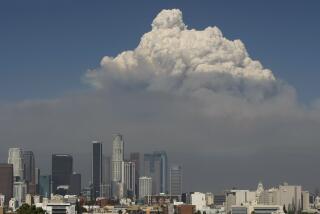These Earthly Infernos
Awe-full, awesome creatures are these huge fires raging through woodlands of Southern California and the West as warming summer weather works its way inexorably north across unusually dry brush and forests. Most Americans witness these blazes as dramatic images of dirty white smoke, yellow flames and orange fire retardant spewing from the bellies of fire-bombing planes. Impressive enough. But up close, where brave humans turn their sooty faces toward the crackling heat, these fires are noisy monsters, each with its own peculiar personality that follows the whim of the winds and the availability of fuel--brush, trees, gardens and the nice houses that increasingly crowd wild-land fringes.
Ahead of the flames come the stuffy scent of smoldering wood and the sight of residents grabbing pets and heirlooms in flight from destruction of what they always thought was their one safe place. Off to the side, where helicopters constantly whop-whop in and out, are camps where professional fire managers, who practiced all winter, study terrain maps, satellite and aerial photos, weather data and computer fire models. Sensors across the West even note every lightning strike. It’s a battle zone of tents with troops grabbing sleep anywhere, radios crackling codes and coordinates, managers running massive field kitchens, truck and bus routes, phone and water systems.
At times, as in Colorado, the strategy is to get out of the way, so fast do wind-whipped flames hop for miles across treetops. At other times, bulldozers and firefighters try to hem flames in, narrowing the front. At night, when humidity rises, fires typically lie down. Fighters pounce with picks, shovels and backfires. By midmorning, like a sleeper rising to the heat, the fires surge. They suck in air from behind to blast hot out front to preheat fuel. Flames do not creep along the ground. One tree, then another and another bursts into flame, a sizzling torch from top to bottom.
At times, orange and bluish flames 100 feet tall whirl about in fiery tornadoes that wobble weirdly across mountainsides, hurling blazing branches like catapults. So intense is this heat, shooting up thousands of feet, that these fires can evaporate rain showers in mid-plummet.
The fire sound is strange, a steady, ominous roar like an immense furnace with the door blown open. This loud rumble ricochets off hills until its eerie echo, like its smoke, seems to come from everywhere. It’s a diligent firefighter who resists distraction.
Often overlooked in the public pandemonium is fire’s natural cleanup role, igniting another life cycle. Most fires hopscotch through forests, leaving at least patches of trees and brush to reseed adjacent burned areas.
This summer’s ashes will feed grasses and wildflowers next spring, if the rains come. And after generations of waiting, lodgepole pine cones, whose natural tar is melted only by a fire’s heat, will have popped open minutes after the flames passed, automatically planting seeds of trees that love sun--to make, in a generation or two, shade for the next species of trees that don’t.
More to Read
Sign up for Essential California
The most important California stories and recommendations in your inbox every morning.
You may occasionally receive promotional content from the Los Angeles Times.










